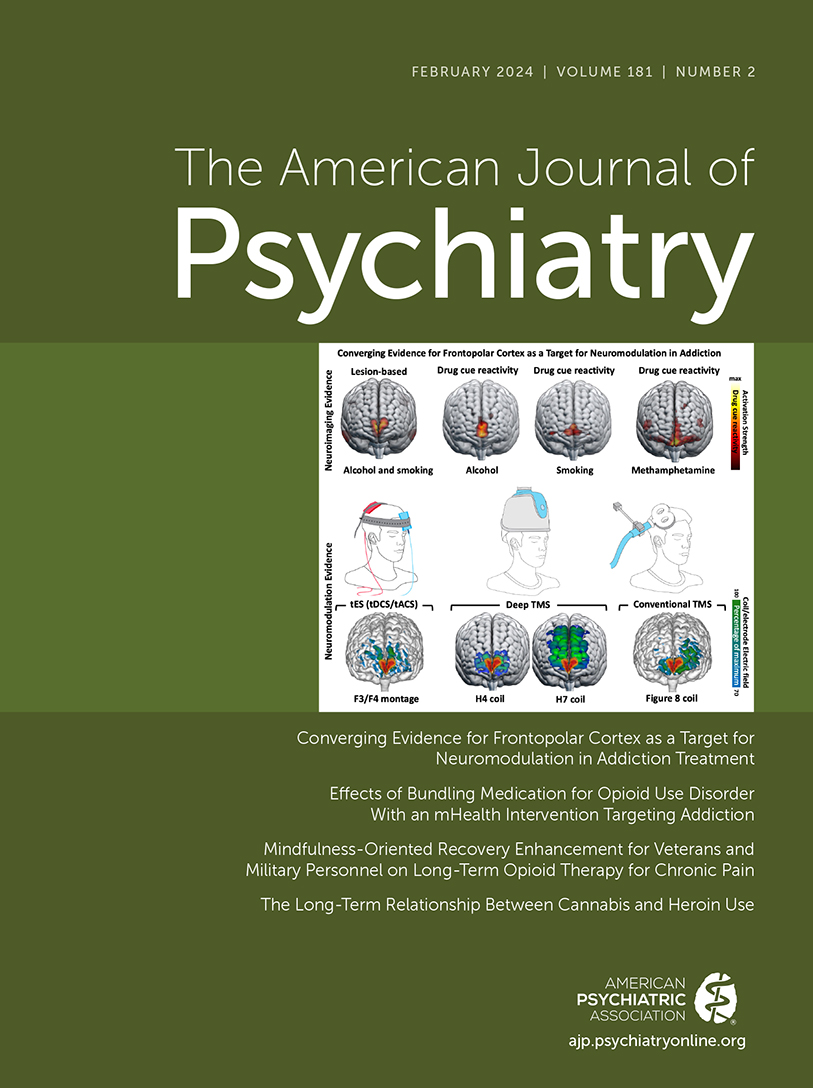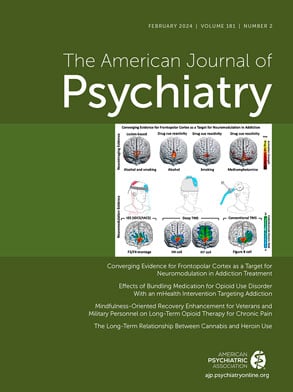Despite being illegal under U.S. federal law, cannabis has gained widespread public acceptance. Over half of U.S. adults (59%) believe that cannabis should be legal for recreational and medical purposes (
1), and nearly one in five (19.6%) report using cannabis in the past year (
2). Cannabis use is particularly common among individuals with opioid use disorder. In clinical samples of people with opioid use disorder, approximately half (51%) (
3) endorse past-month cannabis use and one-quarter (28%) (
4) meet criteria for cannabis use disorder.
As the United States confronts an unprecedented crisis of opioid-related morbidity and mortality, some advocates have asserted that cannabis should be part of the solution. Advertisements from the for-profit marijuana industry have appealed to young people and have implied that cannabis can treat opioid addiction (
5). Several states permit authorizing medical cannabis for opioid addiction. Although there have been no randomized controlled trials demonstrating that cannabis benefits people with opioid use disorder, this controversial concept has impacted drug policy, clinical practice, and public perceptions of viable alternatives for individuals struggling with opioid addiction.
Prospective cohort studies offer a potentially informative window into the possibility that cannabis can replace opioids in adults with opioid use disorder. If, among people with opioid use disorder, an increase in cannabis use is associated with a decline in opioid use, it would support the rationale for fielding clinical trials to evaluate whether cannabis has a therapeutic role in opioid addiction. Prior research on this key point has offered mixed results.
Two previous cohort studies have provided qualified support for an inverse association between cannabis and opioid use among people who use drugs. First, a group-based trajectory study of patients receiving medications for opioid use disorder (MOUD) revealed that patients in the rapidly decreasing and continued low-level opioid use groups had an increased likelihood of also being in the high and increasing cannabis use group (
6). Within these two opioid groups, however, increasing cannabis use was not associated with completion of MOUD treatment as would be expected if cannabis use were conferring clinical benefit. Second, a longitudinal study of middle-aged adults with persistent pain and illicit drug use found that compared with cannabis non-users, those who used cannabis every day were about half as likely to use illicit opioids every day (
7). Because cannabis may improve negative affective states associated with persistent pain (
8), it is unclear whether these associations extend to individuals with opioid use disorder without chronic pain who use cannabis on a daily basis.
By contrast, cross-sectional studies, which are vulnerable to confounding by uncontrolled group differences, have reported that compared with people who do not use cannabis, those who use cannabis are more likely to also use opioids (
9). A cohort study of adults with nonmedical opioid use has further reported that in relation to days without cannabis use, days with cannabis use were nearly twice as likely to also include opioid use (
10). These findings, which were observed without regard to level of pain, suggest that cannabis does not substitute for opioid use. By performing comparisons within rather than between study participants, this study represents a methodological advance over studies of between-participant comparisons. Yet because cannabis and opioid use were assessed on the same day, it was not possible to determine which substance was used first, which is necessary to infer directional causality.
In this context, the new report by Wilson and colleagues in this issue of the
Journal (
11) offers an important advance that bears directly on the causal relationship between cannabis and opioid use among individuals with opioid use disorder. Using data from the Australian Treatment Outcome Study, they identified 615 young people with heroin dependence who were interviewed at baseline and again six times over the following two decades. A cross-lagged panel model was used to evaluate within-person relationships between cannabis and heroin use over time. After controlling for a wide range of potential clinical and demographic confounders, most of the cross-lagged comparisons were not significant, meaning that the level of cannabis use at one time point was not significantly associated with subsequent heroin use, nor was the level of heroin use significantly associated with subsequent cannabis use. The paucity and discrepancy of significant associations argue against a strong directional association between cannabis and heroin use in this population. Such findings are not consistent with claims that cannabis has a role in the management of opioid use disorder. Moreover, the new results suggest that physicians and other clinicians who care for patients with current or past opioid use disorder should view with healthy skepticism the promotion of cannabis-based interventions for this patient group.
The design of the analyses by Wilson and colleagues offers greater methodological rigor than traditional comparisons across patients with MOUD who have varying levels of cannabis use. The new study uses a random-intercept cross-lagged panel model (CLPM), which is a form of structural equation modeling. CLPM focuses on whether two or more variables, in this case cannabis and heroin use, which are measured at two or more time points are associated with each other over time. This model seeks to predict risk of heroin (or cannabis) use at follow-up from cannabis (or heroin) use at an earlier assessment point, controlling for initial level of heroin (or cannabis) use. In order to help distinguish within-person from between-person associations, random-intercept CLPM incorporates between-individual stable traits as latent variables. In this study, observed cannabis and opioid levels were, respectively, regressed on their latent variable counterparts. The latent variables seek to capture each study participant’s general level of cannabis and heroin use. Cross-lagged effects were then calculated between the levels of cannabis and heroin variables that cannot be accounted for by their individual general levels. Calculating within-study-participant effects of cannabis use on subsequent heroin use (and vice versa) in this manner typically provides a better fit than traditional CLPM models and theoretically lowers the risk of spurious associations.
The new study addresses the question of whether, among people with established opioid use disorder, cannabis use is related to increasing or decreasing opioid use. It does not address the broader question of whether cannabis use tends to increase the likelihood of transitioning from non-use to use of opioids or opioid use disorder. According to a recent meta-analysis also performed by Wilson et al. (
12), relative to people who do not use cannabis, those who use cannabis are nearly three times more likely to start opioid use and approximately two and a half times more likely to transition from opioid use to opioid use disorder. In this meta-analysis, however, there were risks of bias and quality concerns about the studies. For example, two of the six studies excluded individuals who used opioids before cannabis and two studies assessed only nonmedical prescription opioids.
The new analysis of cannabis and heroin use also has some limitations, including long periods between assessment points, reliance on self-reported drug use rather than urine toxicology screens, unknown tetrahydrocannabinol potency of cannabis, uncertainty concerning the role of cycling in and out of MOUD treatment, and an absence of clinical outcomes beyond substance use. Nevertheless, this research significantly advances our understanding of the complex relationships between cannabis and opioid use among adults with opioid use disorder and calls into question the assertion that cannabis use effectively substitutes for opioid use among adults with opioid use disorder.
In conclusion, this new study, which involved long-term follow-up of adults with heroin use disorder, raises doubts about the assertion that cannabis use has a role in the treatment of individuals with opioid use disorder. By expanding our knowledge of associations between cannabis and opioid use over time, these findings challenge state medical marijuana policies authorizing cannabis for opioid use disorder and practice claims supporting greater access to cannabis for individuals with opioid use disorder. Because approximately one in five adults with cannabis use have cannabis use disorder (
13) and even higher proportions of people with opioid use disorder escalate from cannabis use to cannabis use disorder (
2), cannabis use in all patients deserves clinical attention. In this regard, it is important to bear in mind that cannabis use disorder itself is associated with a wide range of interpersonal, legal, financial, and health-related problems (
14). From a clinical perspective, patients with opioid addiction, including those successfully maintained on MOUD, who initiate or escalate use of cannabis should be evaluated for evidence-based cannabis-specific interventions (
15).

